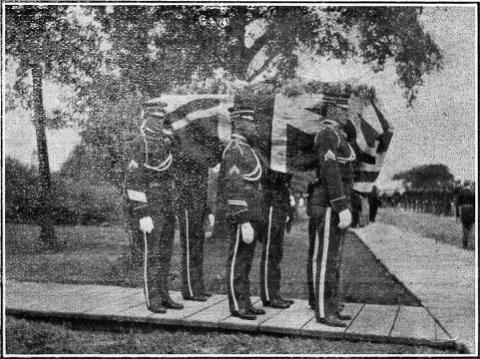Niagara Historical Society: No. 23: Fort Niagara by Janet Carnochan
Fort Niagara
By Janet Carnochan
In this Niagara Peninsula there are many spots with historical associations, battlefields, conflagrations, first parliament, churches, turf clubs, etc., but certainly the most interesting spot is in our view, but not in our territory, across the beautiful boundary river in Fort Niagara, its history predating ours by a century, its many vicissitudes. its varied possessors, Indian, French, British, American, twice besieged and taken, first by the British from the French in 1759, again by the British from the United States in 1813—and twice given back by treaty The name Niagara has different spellings Ongiara, Ouniagahara, etc., (forty different spellings) as given in the documentary History of New York. It is evident that the accent was on the penult syllable instead of the antipenult as with us. In Goldsmith's poem "The Traveller" it is thus pronounced "And Ni-a gar a stuns with thundering sound," but that is no rule for us as the poets are not slow in taking all kinds of poetic license, of both rhythm and rhyme The meaning of the word was often given as Thunder of Waters, but it is now acknowledged to mean simply "The Strait." The country was occupied by the Neutrals, a fierce tribe with thirty-four villages on our side of which Niagara was one and four on the U. S. side. The name Neutral was given because they took no part in the wars between the Iroquois to the south and Hurons to the north, but when these nations were at war allowed free passage to either to reach the other's territory. They were however completely destroyed by the Senecas, and the Hurons were afterwards almost annihilated by the Iroquois as the Eries had been before. The first we know of the neighborhood being visited by the white man was in 1626 by Father Daillon, who is said to have visited the western side of the river, but we really know little of its history till fifty years after that date when the indomitable LaSalle,-;that man of iron, who of noble family destined for the church be came an explorer, endured what we would think frightful hardships saw all his plans fail, tramped over hundreds of miles with a breaking heart and finally though he had once reached the mouth of the Mississippi when coming a second time to explore it by sea, sailed past its mouth unknowingly and was assassinated by his discontented followers.
[...]
The next striking event in the history of the Fort is the war of 1812, a pretty little story is told of General Brock that on the previous Sunday in bidding good bye to some American officers from the Fort who had come over to service in St, Mark's church, he kissed two little girls of Dr. West saying "good bye my little rosy cheeked girls, the next time we meet it may be as enemies." On the morning of the 13th Oct., he sent orders from Queenston to bombard Fort Niagara and this was so effectual that the garrison left and our forces started to cross to take possession, but returned seeing the return of the forces. A story is told of the bravery of a woman, Mrs. Doyle in defence of the Fort, taking the place of her husband a prisoner. Minute guns were fired as a mark of respect at the hour of the funeral of General Brook on the 16th Oct. On the 26th May, 1813, the guns from the Fort gave assistance to the force attacking Niagara. On another occasion red hot shot set on fire the jail and courthouse in which were many prisoners. St. Andrew's Church was destroyed by fire about 10th September before the general conflagration 10th December, 1813.
After the retreat of the Americans and the burning of Niagara, our forces which had been advancing marched in and on the 18th December crossed over and took possession of the Fort, Col. Murray was the leader with him was Captain Hamilton, the guides were said to be Daniel Field and Jas. McFarland, the boats started from a few miles up the river, the struggle was a short one and the occupants of the fort awoke to find themselves prisoners. Partisan accounts tell that those in the hospital were murdered, put to death by our soldiers, One account, however, in telling of the bravery of these men says that they even rose from their beds in the hospital to fight in which case they were combatants and of course suffered as such The commander of the fort Col. Leonard, had spent the night some miles off with his family and only returned to find the British flag flying. The fort remained on the possession of the British during the year 1814, and was given up in the conclusion of peace in March 1815. Although the treaty of Ghent was December, 1814, word did not reach this continent till January, 1815, or the British disastrous attack on New Orleans might have been avoided.
The military graveyard near the Fort is an interesting God's acre. Here no doubt lie buried French, British and American soldiers. There are no inscriptions which go bank farther than the war of 1812. The present military authorities, have now a new cemetery. I said "Why do you not bury in the old graveyard?" The reply was "we do not wish to disturb the dead as whenever a new grave was dug we came upon the bones of those long ago buried." The inscription on an altar stone is peculiar
"Sergeant Amasa Snow died April, 1829 Here lies brave Snow full six feet deep Whose heart would melt when caused to weep Though winter's blast may freeze his frame Yet death's cold grasp can't chill his fame."
The curious mingling of the words Snow, melt, freeze and chill is at least ingenious if not poetic. It was near this that the story runs that the stone to Gene Prideaux was seen.
A singular trace is found here of the American occupation of Fort George and perhaps of history farther back still A young Frenchman, perhaps a son of those of that nationality who helped the Thirteen colonies to gain their independence.
"Ici repose Marie Vincent Boisaubin Lieutenant et adjutant dans le regiment d'artillerie legere des Etats Unis decede an Fort George le 13me aout 1813 a l'age de 22 ans, Ami fidele fils tendre et sincere comment nous consoles d'une perte si severe."
A large monument bears this comprehensive inscription:
A cenotaph erected later is still more comprehensive as it will include French, British and U. S.:"Erected to the memory of unknown soldiers and sailors of the United States killed in action or dying of wounds in this vicinity during the war of 1812."
"To the memory of unknown officers and enlisted men who fought in the early Indian wars on the frontier and also in the Revolutionary War, whose remains are interred in this cemetery."
"To the memory of John Christie (son of the late Major Jas. Christie of the Rev. Army) Colonel of the 23rd Infantry, Inspector of the Northern Division of the U. S. Army died at Lewiston, July 23rd, 1813, aged 25 years, 6 mos., 19 days."
From the unsanitary condition of the camp many of the troops during the American occupation of Niagara were removed to higher ground at Lewiston.
"Sacred to the memory of Adjt. Thos. Poe, Penn. Vol., who nobly died for his country at Lundy's Lane, July 26th, 1814."
This burial must have taken place while Fort Niagara was in the hands of the British.
A very interesting ceremony took place in July, 1911. The remains of soldiers of the Kings's 8th had been found and were buried by 29th Regiment N. Y., a detachment from the Military Camp at Niagara, Gen. Cotton and many of his suite assisting, two chaplains from our camp acted with the U. S. Chaplain. Much discussion ensued as to whether the Kings 8th were there in 1759 or not. It is certain they were present in 1774 and 1780 and that they came to America in 1769. It was a beautiful thought for the two countries to thus unite and was perhaps a friendly return for a similar ceremony at Lundy's Lane when U. S. troops united with the 44th Battalion in burying remains of American Soldiers found at Lundy's Lane,
Kodak views were taken, one, of the four pall bearers of 29th U. S., another of lowering into the grave the remains, another showing two chaplains of our forces in their robes, another with General Cotton with staff meeting Major Syer of the 29th Infantry, United States,
The authorities I have consulted have been the Documentary History of New York, Stones Life of Sir, Wm. Johnson, Hon. Peter A, Porter, History of Niagara County, N. Y., Marshall of Buffalo, Parkman, Col. Cruikshank, Gilbert Family Captivity, john Ross Robertson, Dr. Scadding, Wm. Kirby, Dean Harris, Dr. Coyne, S. P G. Journal, Life of Isabella Graham by American Tract Society and other works.

